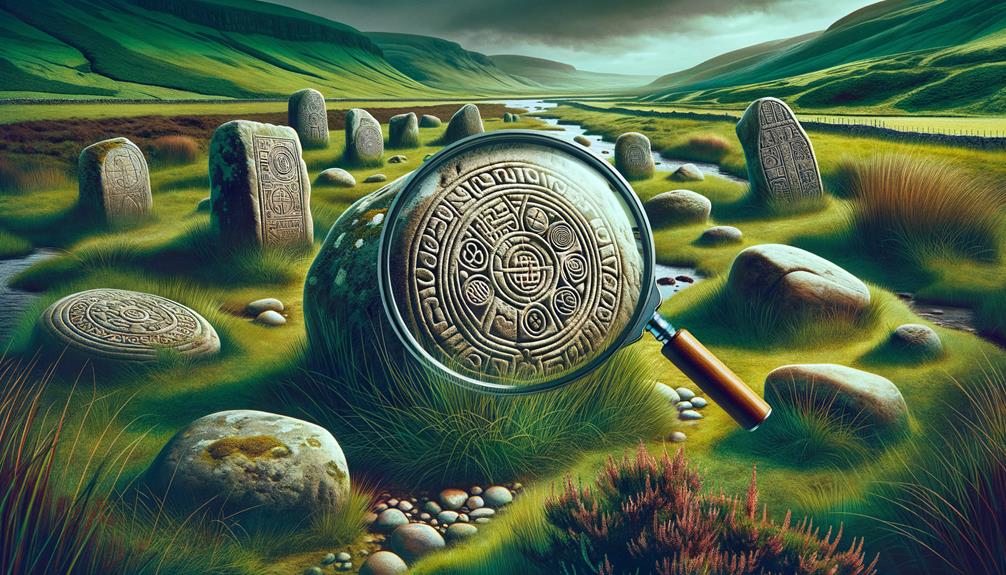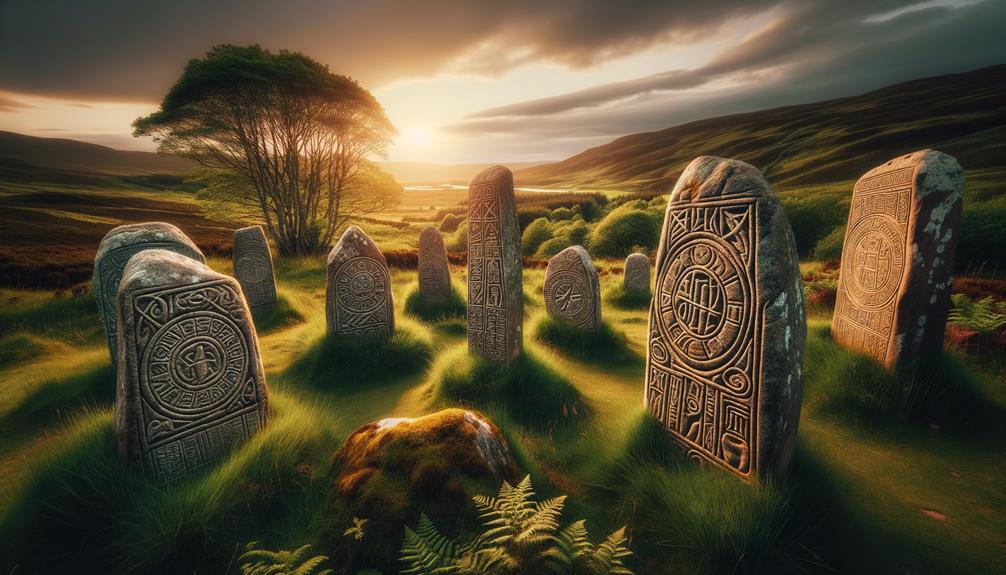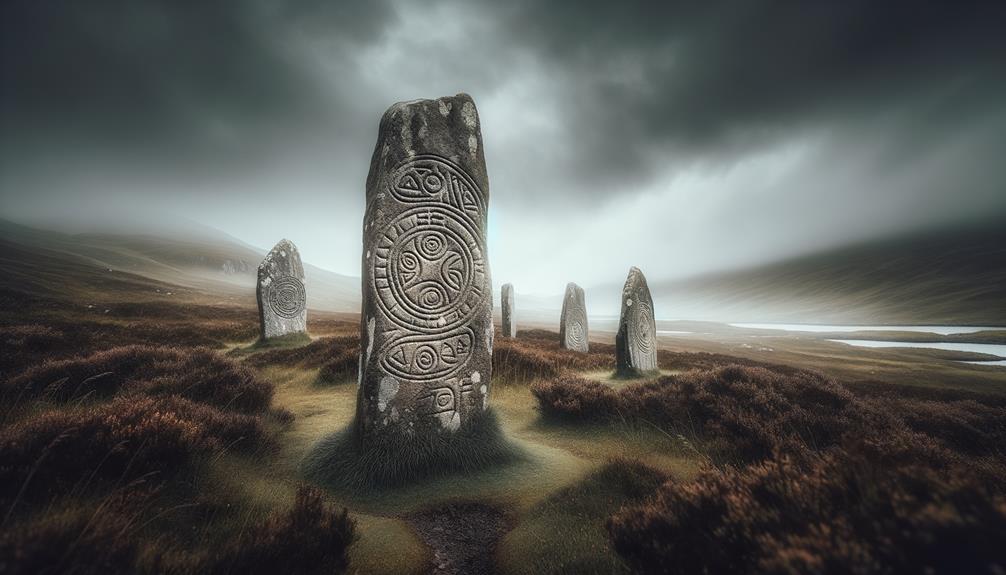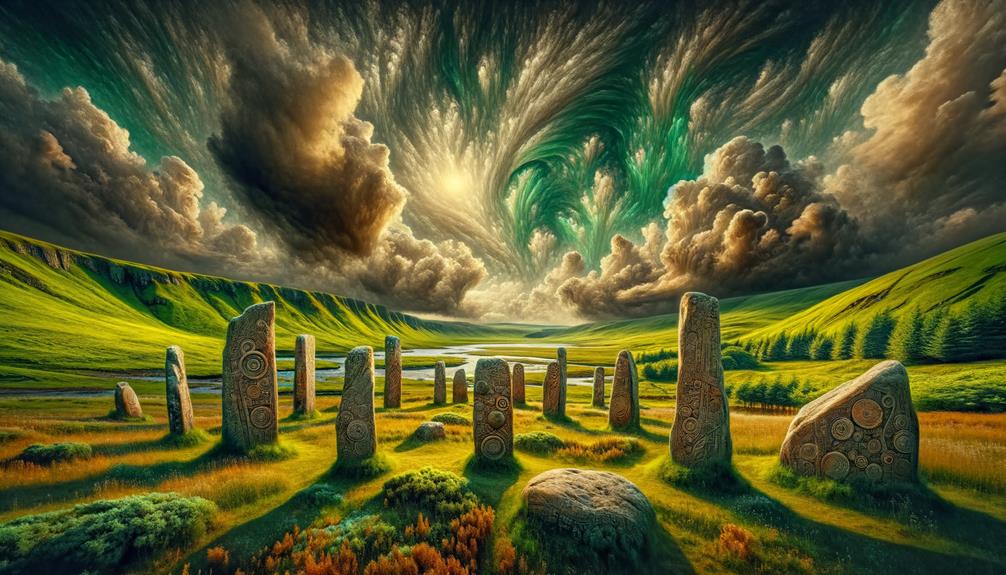Have you ever found yourself deep within the heart of ancient Scotland, gazing upon relics of a civilization long past? Well, I have – and let me tell you, the Pictish Stones are a sight to behold. These stones, adorned with a variety of symbols, tell a story of a society that spanned from the 5th to the 9th century AD.
The symbols on these stones are as varied as the people who carved them – think simple geometric patterns, detailed animal depictions, and later on, Christian elements. They provide intriguing insights into the Picts' beliefs and social structure, all the while being shrouded in the mystery of time.
You see, the animal symbols might have been emblems for different clans, while the geometric patterns could suggest territorial divisions. There are also objects that could represent family lineages. I've spent a fair amount of time studying these stones, and let me tell you – the intermingling of local and Christian symbols is a testament to the impact of external cultures on the Picts.
Each decoded symbol unravels another layer of Pictish society, filling in the blanks of this ancient civilization. But even with all the knowledge we've gained, there's still so much we don't know. It's as if these stones are challenging us, beckoning the brave to uncover more of their secrets. The Pictish Stones, my friends, are a puzzle waiting to be solved.
Understanding Pictish Stones
When you take a casual walk through the realm of Pictish stones, you'll stumble upon three unique types. Each one is bedecked with a variety of symbols that span from simple geometric forms to intricate animal designs and even Christian themes. This mix of influences is a testament to the cultural shifts that took place from the 5th to 9th centuries AD.
Take the Class II Pictish stones as an example. They're easily recognizable by their Christian symbols, mirroring the Picts' transition to Christianity. But they're not just religious artifacts. With their many animal symbols, these stones also functioned as boundary markers or Christian monuments that marked the Pictish Trail.
But here's the catch: the stones' real meanings often slip through our fingers, hidden beneath layers of time and forgotten practices. As we pull back the layers of the Pictish culture, it's important to remember that each stone has its own tale to tell. They're more than just rocks – they're windows into the Picts' beliefs, social organization, and interaction with the world at large.
Decoding Pictish Symbols

Unraveling the enigmatic world of Pictish symbols, I'm on a journey through intricate animal designs, mathematical motifs, and ordinary items, each holding a concealed message we're only now starting to understand. The Picts carved unique representations of animals and object symbols on what we now call Class II or symbol stones.
Here's a quick rundown of Pictish symbols and what they might mean:
| Pictish Symbols | Possible Meanings |
|---|---|
| Animal Designs | Possible Clan Emblems |
| Mathematical Motifs | Possible Signs of Territory |
| Object Symbols | Possible Family Emblems |
| Class II Stones | Evidence of Christian Influence |
The Picts' conversion to Christianity is clearly etched onto these stones, blending seamlessly with their local symbols. Untangling the meaning of these Pictish symbols offers a peek into a culture's secret language, helping to bridge the connection between ancient murmurs and our present-day comprehension.
Locations of Pictish Stones

When you travel to the North East of Scotland, the historical heartlands of the Picts, you can spot the mysterious Pictish stones. These stones can often be found in regions where Christianity was taking root, indicating a blend of religion and culture in that bygone era. You'll find many of these stones moved to safer locations like the Museum of Scotland and the McManus Galleries to safeguard them from the wear and tear of time. However, not all stones are accessible to the public; some are on private properties, recognized but restricted. The movement of these stones from open fields to museum displays signifies the continuing journey of the Pictish stones. Their story, carved in stone, remains a source of fascination and inspiration, right here in the heart of Scotland.
Significance of Pictish Artistry

When we take a closer look at the artistry of the Pictish stones, their cultural and artistic importance becomes apparent. These stones, with their intricate etchings, are a testament to the skill and sophistication of the Pictish society. The symbols, ranging from Pictish beasts to Class II Pictish designs, speak volumes about this advanced society.
Take the carvings at Burghead Fort, for example. They're an interesting mix of Christian symbols and Pictish designs, suggesting a meeting of different cultures. These stones aren't just rocks with etchings; they're visual stories, giving us insight into the Picts' beliefs and societal makeup.
The cultural value of this artistry is hard to overstate. It keeps the Pictish legacy alive, intriguing and inviting further research into their historical and cultural background.
Pictish Stones: A Historical Perspective

When we dive into the history of Pictish stones, we uncover a fascinating narrative. These stones, etched with unique carvings, serve as a testament to the evolving culture of the Pictish people. Two main categories of Pictish stones exist, known as Class I and Class II. Each one boasts various symbols, like the double disc and sea monster, which represent different aspects of Pictish beliefs and history.
To help visualize these categories, here's a simple breakdown:
| Class | Key Characteristics |
|---|---|
| Class I | Primarily incised symbols |
| Class II | More intricate, often featuring Christian symbols |
Burghead Fort, an important location for the northern Picts, is home to a wide variety of these stones. The range of their symbolisms and the evolution of artistic styles show how the Picts interacted with the outside world. This is especially obvious when you consider the profound influence Christianity had on them.
Frequently Asked Questions
What Are the Pictish Symbol Stones of Scotland?
The Pictish symbol stones of Scotland really pique my interest. Between the 5th and 9th centuries AD, these stones were meticulously etched with exclusive symbols, giving us a glimpse into the Pictish way of life. The level of artistry on each stone is absolutely captivating, making them an intriguing spectacle.
What Do the Pictish Symbol Stones Mean?
I find myself drawn to the mystery of the Pictish stones. The symbols carved into these stones might represent names, family ties, or even hierarchical status among the Pictish people. They offer a wealth of cultural knowledge, but their true interpretation remains a topic of ongoing debate. It's like a captivating puzzle from the past just waiting to be solved.
What Are the Symbols of the Pictish Scotland?
I've spent a lot of time getting to know the Pictish symbols of Scotland. There's the Pictish Beast, the Crescent V-rod, and the Burghead Bulls, each one carrying a distinct cultural weight. The precise meanings of these symbols are still a topic of discussion which adds to their intriguing allure.
What Can We Find Out From Pictish Standing Stones?
When we take a close look at Pictish standing stones, we can learn a heap about their society, culture, and belief systems. You see, these stones might have had various roles – they could've been boundary markers, memorials, or even tombstones. Each stone is like a page from a historical book, revealing unique chapters of Pictish history.


